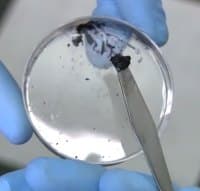A special type of clay could play an important role in the energy storage systems of the future.
Invented by Drexel University College of Engineering’s materials scientists, MXene clay exhibits conductivity on par with that of metals and can be formed into a variety of shapes and size with ease.
MXenes are a family of 2D transition metal carbides and/or nitrides discovered and being developed at Drexel.
“Both the physical properties of the clay, consisting of two-dimensional titanium carbide particles, as well as its performance characteristics, seem to make it an exceptionally viable candidate for use in energy storage devices like batteries and supercapacitors,” said Professor Yury Gogotsi, co-author of a paper on MXene clay to be published in Nature on December 4.
“The procedure to make the clay also uses much safer, readily available ingredients than the ones we used to produce MXene electrodes in the past.”
While electrode materials such as graphene are hydrophobic, meaning it repels water, MXene is hydrophilic.
” The fact that we can now roll our electrodes rapidly and efficiently, and not have to use binders and/or conductive additives renders this material quite attractive from a mass production point of view,” said Professor Michel Barsoum; one of the inventors.
“Being able to make a conductive clay, essentially out of titanium carbide with the help of a common fluoride salt and hydrochloric acid is the materials equivalent of making a chocolate chip cookie – everybody has these ingredients in the pantry.”
The discovery occurred when doctoral student Michael Ghidiu was testing a new method for making MXenes.
An investigation of the clay’s electrochemical performance indicates that its ability to store an electrical charge is triple that reported for MXenes produced by more complex hydrofluoric acid etching; which also uses more toxic materials and is more time and energy intensive to create.
The scientists can now make an electrode in around 15 minutes, whereas the total process using previous techniques could take a day.
The team also report the material doesn’t lose any of its capacitance after more than 10,000 charge/discharge cycles.
Given this is just the first generation of the clay, its future is looking quite exciting for energy storage applications. The team is now working of improving quality and yield of MXene and producing new types MXene.
Related:







































